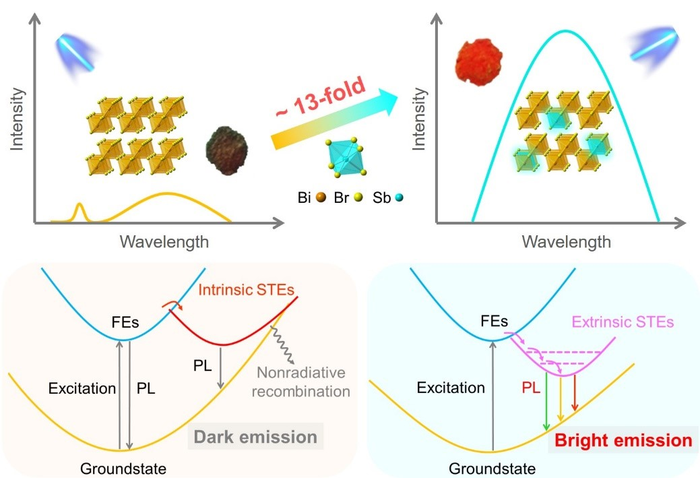Artificial lighting accounts for one-fifth of global electricity consumption, and developing efficient and stable luminescence materials is critical to avoid unnecessary waste of electric energy. The single emitters with broadband emission, such as lead halide perovskites, have recently triggered tremendous attention for artificial illumination and display applications. To develop lead-free and stable perovskites with broadband emission, researchers in China targeted low-dimensional bismuth halide perovskites.

Credit: Ming Shi, Dalian Institute of Chemical Physics
Artificial lighting accounts for one-fifth of global electricity consumption, and developing efficient and stable luminescence materials is critical to avoid unnecessary waste of electric energy. The single emitters with broadband emission, such as lead halide perovskites, have recently triggered tremendous attention for artificial illumination and display applications. To develop lead-free and stable perovskites with broadband emission, researchers in China targeted low-dimensional bismuth halide perovskites.
They published their work on Apr. 15 in Energy Material Advances.
“The single emitters with broadband emission can circumvent critical problems faced in the traditional mixed and multicomponent emitters such as the efficiency losses caused by self-absorption, the complex device structure, and the colors instability due to the different degradation rates of phosphors,” said paper author Rengui Li, a professor with the State Key Laboratory of Catalysis, Dalian National Laboratory for Clean Energy, Dalian Institute of Chemical Physics, Chinese Academy of Sciences (CAS). “Lead halide perovskites have emerged as highly attractive next-generation optoelectronic materials for light-emitting applications due to their extraordinary photoelectric properties.”
Li explained that low-dimensional organic-inorganic hybrid lead halide perovskites dominate the research of broadband emission benefiting from their strong electron-phonon coupling interactions inducing the generation of self-trapped excitons.
“However, the toxicity of lead and intrinsic instability caused by organic cations hinder their further commercial applications,” Li said. “Therefore, it is imperative to develop inorganic lead-free halide perovskites with high-efficiency broadband emission.”
Bismuth-based halide perovskites have attracted considerable attention in optoelectronic fields due to their low toxicity, good chemical stability and the isoelectronic configuration of Bi3+ with Pb2+. According to Li, the Cs3Bi2Br9 has emerged as an emitter for light-emitting applications given a large exciton binding energy to promote the exciton recombination efficiently. However, there are a few reports on Cs3Bi2Br9 for broadband light emission at ambient temperature and pressure, although the low electronic dimensionality and strong quantum confinement brought by vacancy-ordered layered structure endow it that potential.
One of the dominant reasons is that Cs3Bi2Br9 possesses extremely strong exciton-phonon coupling because of the localized and compressed microstructure, Li said that can result in self-trapped excitons responsible for the broad photoluminescence band being more susceptible to thermal quenching through emitting phonons nonradiative, thus Cs3Bi2Br9 only exhibits broadband emission at low temperatures or high pressure. Li and his team have been made to develop the broadband emission for Cs3Bi2Br9, and more importantly, to figure out the luminescence mechanism.
“In this paper, we have successfully incorporated a trace amount of Sb (0.13 wt.%) into the Cs3Bi2Br9 without disturbing its long range structure,” Li said. “The resulted Cs3Bi2Br9:Sb exhibits a prominent broadband emission and an remarkable enhancement of photoluminescence quantum yield (PLQY).”
“The enhanced PLQY is attributed to the regulation of the exciton recombination pathways by Sb incorporation and the nonradiative recombination of self-trapped excitons decreases,” Li said.
Femtosecond transient absorption spectra reveal the presence of different energy levels of self-trapped excitons, and after photoexcitation, the excited free excitons transfer to self-trapped excitons undergoing through the gradient energy levels, and the extrinsic self-trapped excitons at various energy states contribute to the broadband emission, Li said, the Cs3Bi2Br9:Sb exhibits excellent structural and optical stability for months, which paves a way for the potential luminescence applications for the lead-free halide perovskites.
Other contributors include Ming Shi and Can Li, State Key Laboratory of Catalysis, Dalian National Laboratory for Clean Energy, Dalian Institute of Chemical Physics, CAS; Bin Yang and Keli Han, State Key Laboratory of Molecular Reaction Dynamics, Dalian Institute of Chemical Physics, CAS; Siping Liu and Ruiling Zhang, Institute of Molecular Sciences and Engineering, Shandong University.
The following authors have additional affiliations: Ming Shi and Can Li, University of Chinese Academy of Sciences; Keli Han, Institute of Molecular Sciences and Engineering, Shandong University.
The National Key Research and Development Program of China (2021YFA1502300), the Fundamental Research Center of Artificial Photosynthesis (FReCAP), the National Natural Science Foundation of China (22088102 and 22090033), and Youth Innovation Promotion Association of Chinese Academy of Sciences supported this work.
##
Reference
Authors: Ming Shi,1,2 Bin Yang,3 Siping Liu,4 Ruiling Zhang,4 Keli Han3,4 Can Li,1,2 and Rengui Li1
Title of original paper: Tuning Exciton Recombination Pathways in Inorganic Bismuth-Based Perovskite for Broadband Emission
Journal: Energy Material Advances
DOI: 10.34133/2022/9845942
Affiliations:
1State Key Laboratory of Catalysis, Dalian National Laboratory for Clean Energy, Dalian Institute of Chemical Physics, Chinese Academy of Sciences, Dalian 116023, China
2University of Chinese Academy of Sciences, Beijing 100049, China
3State Key Laboratory of Molecular Reaction Dynamics, Dalian Institute of Chemical Physics, Chinese Academy of Science, Dalian 116023, China
4Institute of Molecular Sciences and Engineering, Shandong University, Qingdao 266237, China
About the author:
Rengui Li received his PhD Degree from the Dalian Institute of Chemical Physics (DICP), Chinese Academy of Sciences in 2014. He worked as a Visiting Research Associate in Prof. K. Domen’s group at the University of Tokyo in 2011 and Prof. Harry Atwater’s group at California Institute of Technology from 2019 to 2020. In 2014, he began to work at the State Key Laboratory of Catalysis in DICP as an Associate Professor. Since 2018, he was promoted as a Full Professor at DICP. His research interest is mainly focused on photocatalytic solar energy conversion. He has published more than 60 scientific papers with 4700 citations, and the journals include Joule, Nature Commun., Angew. Chem. Int. Ed., Adv. Mater. Energy Environ. Sci., etc.
Journal
Energy Material Advances
DOI
10.34133/2022/9845942
Method of Research
Experimental study
Subject of Research
Not applicable
Article Title
Tuning Exciton Recombination Pathways in Inorganic Bismuth-Based Perovskite for Broadband Emission
Article Publication Date
15-Apr-2022
COI Statement
The authors declare no competing financial interest.




